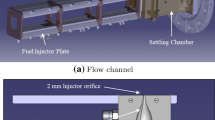Abstract
The extinction limits of unforced and periodically forced turbulent counterflow flames have been measured with equivalence ratios of relevance to lean-burn gas turbines. Thus, the opposed flows comprised mixtures of methane and air with the same equivalence ratios in the two streams in the range of 0.5 to 0.7 and also mixtures with equivalence ratios less than 0.7 in one flow and the other with an equivalence ratio of 0.9. The oscillations were imposed by loudspeakers and forced flame extinction was shown to depend on the total duration of pulsation. Extinction times were measured by forcing the flow with a sinusoidal signal of specified frequency, amplitude and duration and, if extinction did not occur, the time of pulsation was increased and the procedure was repeated until extinction took place. A form of chemiluminescence was used to observe the flame front with and without oscillation and gated measurements of the axial and radial velocity components quantified the phase lag between the input signal and the flow as a function of frequency.
Extinction strain rates increased with equivalence ratio and were greater for asymmetric than symmetric flames with the same total quantity of fuel and total equivalence ratios below 0.7, based on the fuel and air mixtures of both streams. For example, asymmetric flames of 0.6 total equivalence ratio extinguished at bulk strain rates 70% higher than those of symmetric flames. The forced flames withstood instantaneous strain rates larger than the critical values for unforced flame extinction and survived for up to 100 cycles in the frequency range from 200 to 1000 Hz with instantaneous strain rates equal to the unforced extinction limit. Symmetric flames had shorter extinction timescales and were more sensitive to changes in the equivalence ratio than asymmetric flames of the same total quantity of fuel. The visualisation showed that the light intensity emitted from CH radicals varied in phase with velocity signals so that it initially decreased with increasing strain and increased as the strain reduced, consistent with a tendency to extinguish and then re-light.
Similar content being viewed by others
Author information
Authors and Affiliations
Additional information
Received: 16 March 1998/ Accepted: 26 October 1998
Rights and permissions
About this article
Cite this article
Sardi, K., Whitelaw, J. Extinction timescales of periodically strained, lean counterflow flames. Experiments in Fluids 27, 199–209 (1999). https://doi.org/10.1007/s003480050345
Issue Date:
DOI: https://doi.org/10.1007/s003480050345



